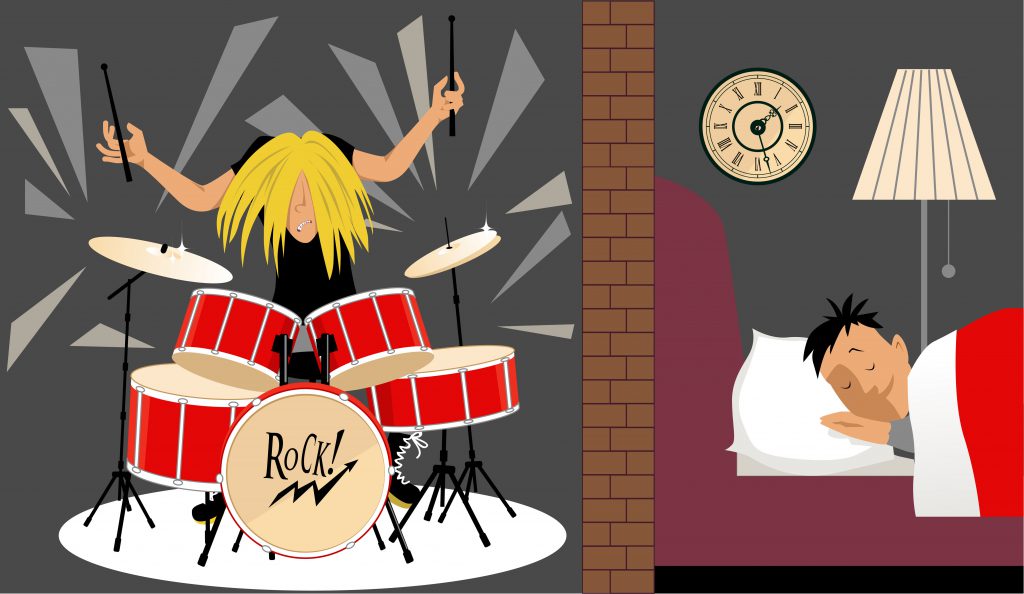By Erica Rascón on January 17, 2018 in News
When J Turner Research president Joseph Batdorf released the most recent survey on top residents complaints, he issued the following statement: “Apartment residents remain concerned with a broad range of customer satisfaction issues but far and away the immediate opportunity to improve customer service and resident satisfaction lev els is by addressing dissatisfaction with onsite staff responses to resident concerns.”
els is by addressing dissatisfaction with onsite staff responses to resident concerns.”
When noise complaints besiege your front office staff, you have options to address residents’ concerns without a major renovation. Improve resident satisfaction with affordable soundproofing retrofits.
The tips below will help you jumpstart the conversation with your contractor.
Unforeseen Challenges
Before you can fix the noise problem, you must identify the source.
In some cases, your building may not have been built to code even though it received a certificate of occupancy (COO). New and remodeled multifamily construction is required to have an STC of 50 by design and 45 by field test. Sometimes, building inspectors often overlook noise control.
If you’re frequently receiving noise complaints, you could hire an acoustician to verify if the building was built to sound code. That may be a slippery slope that you’d rather avoid.
Instead, understand the root of the sound leaks. Then you can find the most cost-effective solution.
For example, during drywall installation, many contractors will raise the gypsum board to create a snug fit between the wall and ceiling. This leaves a gap at the base. Contractors will hide the gap with the baseboard and forego proper caulking techniques. The resulting void permits sound to travel between units and rooms.
Older buildings may have multiple causes for noise transfer. Single-pane windows, hardwoods without soundproofing underlayment, and even old or damaged insulation may be at the root of your residents’ complaints.
Solutions
Quiet Clause The easiest and least expensive way to reduce noise complaints in your multifamily community is to institute a quiet hours clause. The quality of this clause, however, is dependent upon your site’s readiness to enforce it.
Wall Additions Ensure that shared walls are actually insulated. This is more of an issue for older construction but even new construction benefits from a check. If insulation is missing, fiberglass or cellulose insulation can considerably decrease noise contamination between units. When insulation is not the problem, sound isolation clips on the drywall can reduce sound transition by 8-10 dB, or the equivalent of 45-50 percent of noise perceived by the human ear.
Since that requires installing new drywall, consider this added bonus: adding 5/8 inch or ½ inch drywall with viscoelastic damping compound between layers can reduce noise transfer between walls. Green Glue is a popular viscoelastic damping material. Once dry, it remains flexible, improving its ability to isolate vibrations. Such flexible materials promote constrained layer mass damping, an acoustician way of saying that it minimizes sound’s ability to travel between layers of drywall.
Underlayment Solid flooring has become increasingly popular due to its durability and hypoallergenic properties. Unfortunately, footfalls easily resonate between units. True resilience, which isolates impact footfall noise, is hard to come by. Many underlayment products portray false ratings. Truly resilient products reflect the properties of rubber rather than carpet or a solid surface.
Also consider that if you have a concrete sub floor, a thin resilient material can accomplish great RST results. Wooden sub-floors, however, will require a thicker resilient underlayment. To keep costs low, this may mean different underlayment for different levels of your structure.
Windows Ideally, your structure has double-paned windows that are sealed with weatherproof, acoustical caulk and insulate. That’s likely not the case. But before replacing the entire window or casing, first check the integrity of the weather stripping. If the weather strip is worn, it’s letting air and sound travel between spaces. Replacing the weather strip is a quick and inexpensive way to keep outside noise outside.


